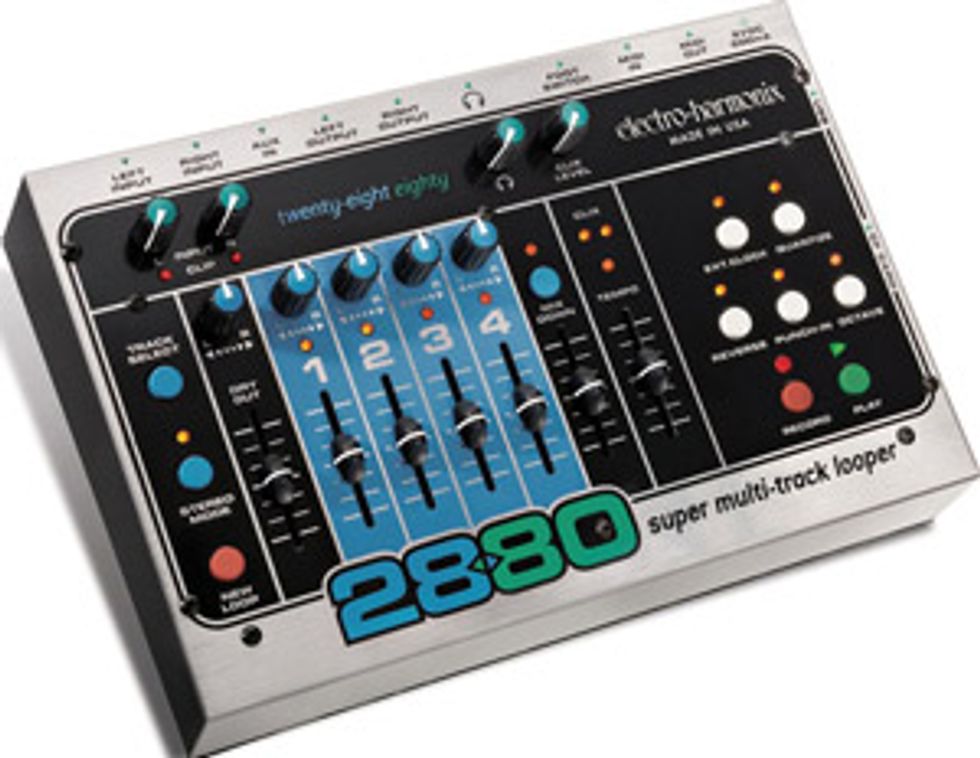
The box that changed my viewpoint on reading manuals: The Electro-Harmonix 2880 Stereo Multi- Track Looper. I wish I’d dug into this five years ago.
This month I want to explore the way in which we interact with new equipment and how we can optimize that experience. When it comes to new gear (and by gear, I mean all appliances—TVs, DVD players, computers, etc.), I believe that people fit into one of two categories.
Category 1 includes those folks who, once the new purchase has been unwrapped, proceed to read the instruction manual from cover to cover. Individuals in this category may even have read online manuals for the device prior to purchase. They want to hear what the company that produced the unit has to say, and they want to know the full range of options their new appliance is capable of.
Category 2 describes those who immediately start to use the unit the moment they pull it from the box. These people learn as they go. Category 2 people are often quite intuitive and they enjoy the process of discovery. I’ve always been a Category 2 person, that is until quite recently. I believe when it comes to music gear, approaching things with a blank slate can reap great dividends— no preconceptions to color what could potentially amount to innovative and unique sounds. Category 2 folks display an almost anti-establishment attitude: “Screw the directions, I’ll find my own way of using this!”
I think this is one of the reasons Apple has arrived at where they are. The company’s approach has always been to make things as intuitive as possible—things are where you expect them to be, and when you need something, it seems to almost magically appear. Apple’s devices are so cleverly engineered that users can whip a device out of the box, turn it on, and get on with what they want to do.
Ironically, I’ve recently been getting an enormous amount more out of my MacBook Pro after going through some high-quality online instructional videos, and this has caused me to shift my thinking. Rather than resenting the idea of having to read a whopping great manual before getting into the fun of playing with the new toy, I now see an instruction manual as an additional treasure trove of goodies—a Santa’s sack of additional features to be drawn upon as my heart desires. Wow—what good news!
As far as this “studious” approach reducing my capacity for innovative use … meh. I try to give myself more credit—I’m not going to allow a manual to curb my creativity. Instead, I’m going to allow the manual to expand it.
Now, let’s bring the discussion back to guitar-specific gear. Be it the most straightforward fuzz pedal or a complex rackmounted DSP device, I urge you all, read the manual. Treats a-plenty await.
To give you an example: Some years ago I was gifted an EHX 2880 Stereo Multi- Track Looper. I attempted to use my “get in there and rock out” approach. Not such a good idea. I got it to work. I got it to record and I got it to loop. But not to a point where I could use it live. Fast-forward five years, where suddenly I was in a gigging situation that urgently needed a looper. I thought, “Hmm, it could be time to check out the 2880 again.” So I did and I also read the manual. Handy. Very, very handy. Suddenly it all became a lot clearer and I cheerfully floated off into loop land—a magical destination I could have spent the previous five years frequenting, had I embraced the rite of manual reading earlier.
Some manuals will offer nothing new to the user, but the only way you’ll find this out is by reading it. The worst-case scenario is there are no hidden gems and you can provide yourself with a celebratory slap on the back for “already knowing all there is to know” about device X. However, there just might be goodies—unanticipated bounty for the intrepid manual reader— that could open doors to previously unconsidered sonic vistas. This would be rather lovely, don’t you think?
Finally, in my previous column [“Stop ... Smell the Roses,” January 2012] I asked readers to submit their most off-the-wall guitar tone story. Thanks to everyone who entered, I read some wonderful tales of using headphones as microphones, 4-track recorders being blown up, and the attempt to faithfully reproduce Eddie Van Halen’s “You Really Got Me” tone with a Peavey Rage. I’m happy to announce that Chad K is our winner—a shiny new Medusa is on its way to you now! You can check out his story in the online version of this article at premierguitar.com or on the Red Witch Facebook page (facebook.com/redwitchpedals). Until next time—keep rocking!











![Rig Rundown: Russian Circles’ Mike Sullivan [2025]](https://www.premierguitar.com/media-library/youtube.jpg?id=62303631&width=1245&height=700&quality=70&coordinates=0%2C0%2C0%2C0)














